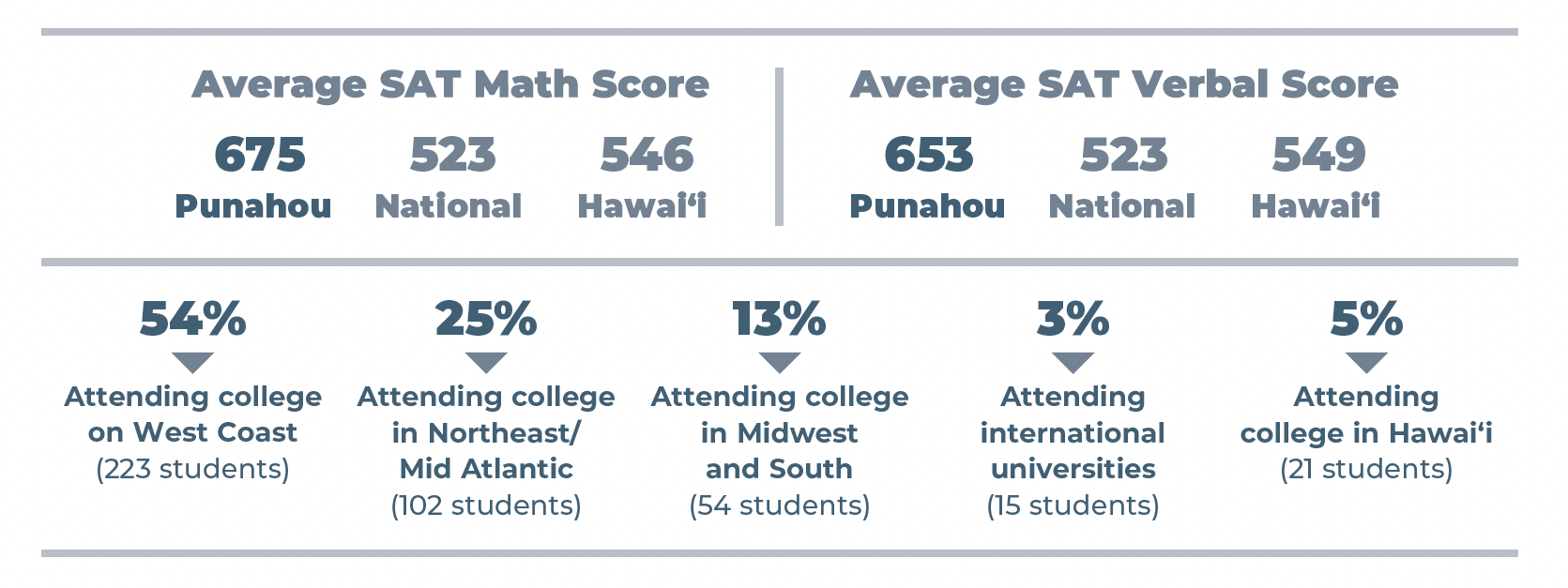
BY DIANE SEO ’85
ILLUSTRATIONS BY TILDE OYSTER ’22
College Admissions
Alumni Perspectives
Changes had already been brewing in college admissions pre-pandemic, but after COVID-19, the landscape was dramatically altered. For one thing, standardized tests became optional at many colleges across the country, with schools looking beyond transcripts and SAT scores to assess applicants. This led to record numbers of applications at many selective colleges, which then reported lower acceptance rates. More students also have been seeking financial aid as costs continue to soar.
The dizzying array of developments have required high school seniors, including at Punahou, to be strategic when applying for admission. Terri Devine, Punahou’s director of College Counseling, said the School’s team of counselors develop a specific strategy for each student based on their individual academic record, finances and preferences.
“We help them find the academic, social and financial fit, and make sure all three are covered in their choices,” she said. “We talk about big schools, small schools, liberal arts colleges and large research universities. We have them look at the clubs and organizations that are active on campuses, read the college newspapers online to get a sense of the social fit as well.”
Instead of focusing on rankings alone, Punahou’s ultimate aim is to steer students to schools where they are most likely to be happy and successful – places where they can thrive because their personal aspirations can be met, President Mike Latham ’86 said. “Punahou graduates continue to attend the most highly rated colleges and universities in the United States, which we are justifiably proud of. Personally, however, I believe you can get an outstanding education at any one of about 200 institutions of higher education in this country,” he said. “This means that students should worry a bit less about composite rankings published in a magazine or guide and a lot more about what a specific school offers and what their experience may actually be like if they attend.”
“Punahou graduates continue to attend the most highly rated colleges and universities in the United States, which we are justifiably proud of. Personally, however, I believe you can get an outstanding education at any one of about 200 institutions of higher education in this country.”
PRESIDENT MIKE LATHAM ’86
At Punahou, students have countless opportunities to discover and explore their interests through academic courses, co-curricular programs and other channels. Attending college then becomes a continuation of their journey to pursue what inspires them. “The key is to know yourself and engage in enough reflection about what matters to you to find a place where you can thrive,” Latham said. “What you do at college is also much more important than where you happen to go.”
Punahou Academy students and their parents meet regularly with a college counselor throughout the application and decisionmaking process. They also have access to a variety of resources, including the MaiaLearning platform, which allows them to research schools and scholarships, evaluate their chances for admission and keep their applications organized and on track. MaiaLearning also links with the Common Application, which makes sending out applications to multiple schools easier.
The School’s counselors also communicate regularly with admissions officers around the country. “I think people would be surprised to know just how much interaction we have with college admissions officers,” Devine said. “They tell us things we need to know as we send applicants their way, including what’s changed from their perspective.”
Since the pandemic, Punahou’s counselors have noticed students being far more careful about selecting schools. They’re also more cost conscious. For instance, even though a school may have a strong academic reputation, it has to feel like a place where the applicant will belong, especially coming from Hawai‘i.
To help students assess different schools, Punahou’s Parent Faculty Association (PFA) partners with the College Counseling Department to host an annual program, where alumni share their college experiences with current students. Their first-hand accounts have proven to be highly valuable to students and parents. “When current Punahou students talk to alumni about schools, they can identify with them, and that’s powerful,” Academy Principal Emily McCarren said.
Despite the turbulence of the times, McCarren believes many of the changes happening in college admissions are beneficial to students. “The national conversations around them are arcing towards improving things for kids – improving their well-being, making sure that they can communicate their authentic selves more fully, and making sure there’s greater access for broader ranges of kids from different backgrounds,” she said.
Colleges are clearly seeking students with a “special spark,” with interests and passions that relate to life outside of school, she said. This aligns with what Punahou has been aiming for with its curriculum. “All of our programs are about inviting kids to explore different pathways of their interests and finding things that ignite them,” she said. “We don’t do this because of college admissions, but our colleagues at colleges and universities want kids in their community who are engaged in these ways.”
Test-optional policies require individualized strategies

During the 2021 – 2022 admission season, many of the nation’s competitive universities were deluged with applications, while smaller and less recognized schools saw declines. This was largely attributed to colleges no longer requiring standardized test scores, but rather, making them optional. While the pandemic had made it difficult for many students to take such exams as the SAT, colleges had already been looking for ways to evaluate applicants’ strengths outside of standardized scores. This led to record-high applications and decreased admission rates at many selective colleges. Harvard, for instance, accepted only 3.4% of its more than 57,000 applicants, compared to 4.9% the previous year – its lowest admission rate ever.
About 44% of Duke University’s applicants didn’t submit SAT or ACT scores during the last admissions period, according to Christoph Guttentag, the school’s dean of undergraduate admissions. “I think a significant number of those students felt that their SAT or ACT scores might not have been the strongest part of their application, so they felt as if they could be stronger candidates without them,” he told the university’s newspaper, The Chronicle.
With high SAT scores no longer a necessity, a larger, more divergent pool of students submitted applications to many schools, resulting in colleges enrolling a more diverse group of students. At New York University, 29% of this year’s admitted students were underrepresented minorities, while 20% were first-generation college students and 20% were eligible for federal Pell Grants. “In the most unusual year in higher education in living memory, one in which all the traditions of the admissions process – standardized tests, campus visits, get-togethers at high schools around the country – were turned on their head, we have nonetheless had an exceptional outcome: an unprecedentedly diverse class of outstandingly talented young people,” NYU President Andrew Hamilton said in a statement.
At the University of California’s (UC) nine undergraduate campuses, about 45% of the admitted freshmen were from low-income families, while 45% were the first in their families to attend a four-year university. Like many other colleges across the country, UC schools found that high school transcripts, as well as activities and essays, provided enough information to assess such qualities as grit, creativity and leadership. “Those factors are sufficient to make a decision, and I hope this is a new wave of the future for lots of institutions,” Youlonda Copeland-Morgan, UCLA vice provost of enrollment management, told the Los Angeles Times.
With COVID-19 still a concern, many schools continued to make standardized tests optional this admission season – a policy that could persist well beyond the pandemic. So how does this affect Punahou students? The School’s counselors say it’s more essential than ever to have a sound plan. In regards to standardized tests, Punahou still encourages students to take them, because high SAT, ACT and Advanced Placement scores still can provide an edge. Thus, if students score well on any standardized test, they are advised to submit them, because anything they can do to showcase their abilities and achievements can bolster their applications. If students, on the other hand, do not do well on standardized tests, they might want to take advantage of the test-optional policy and highlight other things about themselves.
“There’s a strategy around whether or not to submit scores,” said Terri Devine, Punahou’s director of College Counseling. “Students should be fully aware of the testing landscape, but if they choose not to submit scores, we want them to know we can help them tell their story in other ways besides a test score.”
Alumni Perspectives
Harrison Lyckman ’18
PURDUE UNIVERSITY
For students from Hawai‘i, familiarity is very often a driving factor in choosing a college – a West Coast school, for example, in a similarly multicultural setting and often with a large contingent of Hawai‘i kids already studying there. For Harrison Lyckman ’18, it was the opposite: He chose Purdue University in Indiana specifically to embrace the unfamiliar. “That was probably the main driving factor of why I came to Purdue – I wanted to get as far away from home as possible to step outside my comfort zone and help me grow,” he says. “It’s forced me to relate to the differences between people. People here, the majority of things we have in common are differences. I think that’s important in building relationships: embracing the differences between people, not just the similarities.”
Far from the coasts, in the heartland of the country, Purdue has a largely Midwestern student population that is nearly two-thirds White. At orientation, Lyckman met someone who had never seen an ocean. He was asked what language people speak in Hawai‘i. Rather than isolating, he found these encounters fascinating, especially when he realized that his own ethnic background and upbringing in Hawai‘i were points of friendly curiosity for his fellow students. He reached out, mentoring freshmen interested in pharmacy (Lyckman will graduate from Purdue’s Doctor of Pharmacy program in 2024), and going well beyond his comfort zone to take an active role in the school’s annual dance marathon to raise money for a local children’s hospital.
“There are times I miss home and seeing people who are similar to me. In group chats with my friends I see them all hanging out on the weekend and I’m like, oh man, I wish I was with them,” he says. “But I’m glad I came here because I’ve been able to meet so many different people. It’s forced me to branch out.”
– By Mari Taketa
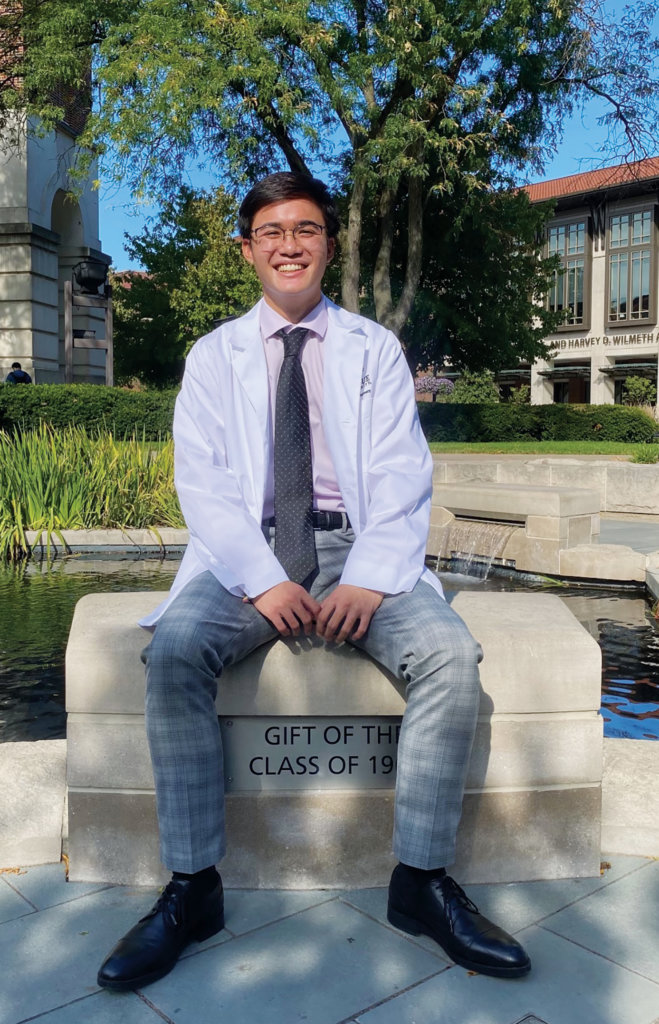
“You have to think about whether you are doing all you can to transition and settle in. The answer for me was ‘no.’ I had to become more outgoing, more social. The transition from high school to college isn’t easy. Do everything you can to make it easier.”
– Harrison Lyckman ’18

Alumni Perspectives
Elsa Kronen ’20
UCLA
Elsa Kronen ’20 could picture it: Attending a big university, part of a student community steeped in school spirit, in a city where opportunities during and after college were endless. But no one campus stood out. So in her senior year, Kronen applied to nearly 20 schools. It wasn’t until she got on the waitlist at the University of California at Los Angeles – and felt immense, unexpected joy when she was accepted – that the question was settled: She knew she would be a Bruin.
Two years later, her elation hasn’t changed. The Class of 2020 experienced many disruptions due to COVID-19 – Punahou traditions and for many, freshman year on campus, at college.
“There are a lot of students who are academically driven and want specific Ivy League schools, when there are so many schools that have the same great traits and where you may be happier. Focus on where you would be happiest.”
– Elsa Kronen ’20
Kronen spent her first quarter at UCLA at home in Honolulu, logging onto Zoom lectures with 300 other students at a time. The rest of the year, she rented an apartment near UCLA with three Punahou classmates – Mia Viola and Sarah Mettias, both also Bruins, and Jade Hagihara at Loyola Marymount University – and while their friendships tightened, Kronen couldn’t help feeling like she was missing out on meeting some of the 31,000 other undergraduates. Freshman year felt like a year suspended, of being so close yet wondering what college life really was like, and when it would begin.
Thankfully, it began this past fall. Kronen moved into a dorm, registered for in-person classes and bought season tickets to Bruins football games. A cousin from California is on the UCLA women’s water polo team, so she’s attending those matches; and having competed in swimming at Punahou, she’s thinking about joining club swimming or even rowing. “Thinking back now, I’m very happy to be going to UCLA. There are so many different people, and most are really academically driven, but they have good balances – they’re athletes too or have extracurriculars or internships or a good social life. I like the energy,” she says. “I feel like there’s a lot of opportunities since it’s such a big school and there are so many good professors and opportunities in L.A. I just love everything about it. I know it’s a cliché but I can’t really imagine myself at any other school.”
– By Mari Taketa
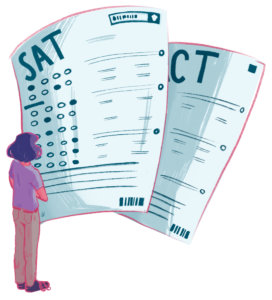
Applying early gives a distinct advantage, but it’s not for everyone
The data is irrefutable. Colleges across the country are admitting a significantly higher percentage of students who take advantage of early admission programs than those who don’t.
“We used to see colleges admitting 30% of the freshmen class through a binding early decision program; now we’re seeing 50 and 60% of the seats available being filled through these types of early application programs,” Punahou College Counseling Director Terri Devine said.
Because applying through the regular decision round can be more competitive, many students are eager to apply early. But again, a strategic plan must be shaped for each student, with an understanding that early admission programs aren’t for everyone.
There are two types of early admissions programs – early decision and early action. In early decision, students have a binding commitment to attend the school if admitted. With early action, students learn of their acceptance typically in November or December (as opposed to the spring of the following year), but are not bound to attend. Because of this, early action tends to be a more popular choice.
A few of the most selective colleges, including Stanford, Harvard, Yale and Princeton, offer a “restrictive early action” option. Through this program, students are permitted to file only one early action application, but there is no binding agreement. This option still must be weighed carefully because students may be giving up merit scholarships or offers of admission from other colleges.
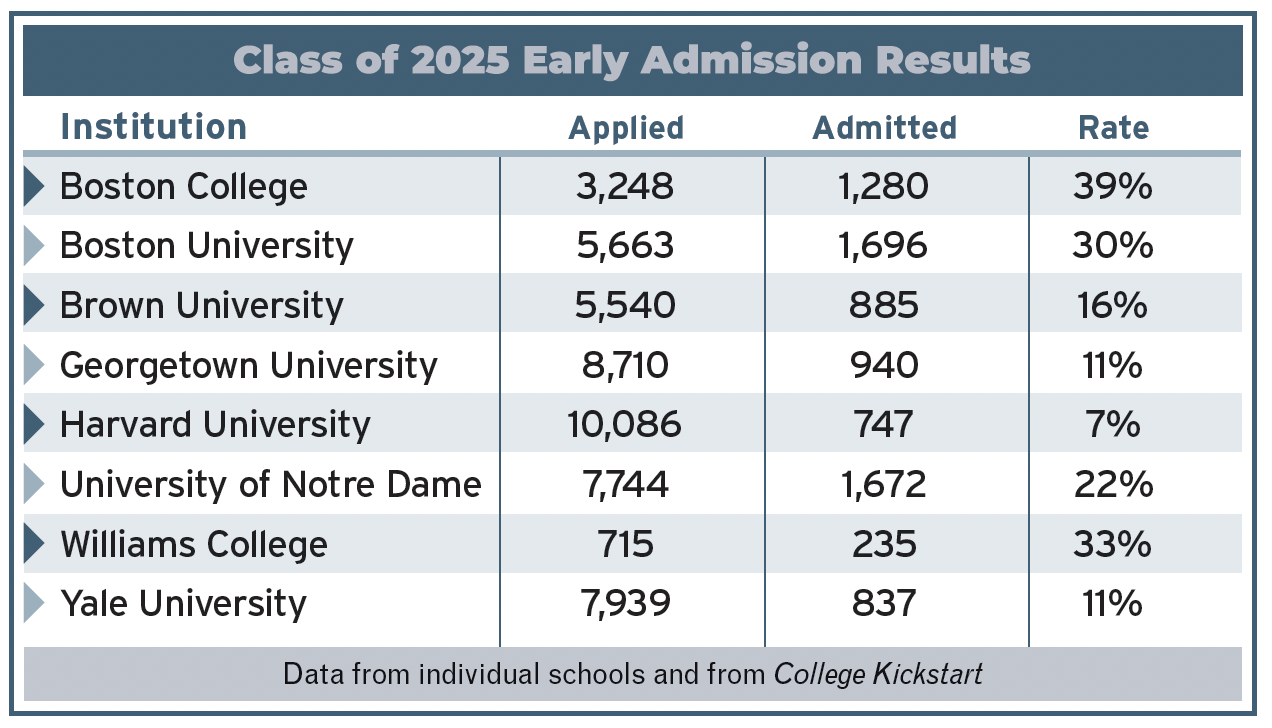
For those seeking financial assistance, the drawback to committing to one school is that they won’t be able to compare financial aid offers from various schools. They might then miss opportunities for more funding because they are bound to one school.
Thus, Punahou’s college counselors caution students and their families to consider their personal circumstances before committing to any school. “Choosing between early action, early decision, restricted early action, early decision round 2, rolling or regular admission requires strategy, and that’s where the college counselors come in to offer advice and insight,” Devine said. “A lot of the work that we’re doing right now with seniors is developing their final college list and developing a strategy for early versus regular decision. It’s very individualized, because for some students, they need the fall semester to take the SAT again or to take certain courses, and if they decide to apply early decision, they need to know they are committing to an institution – and that’s not something to take lightly.”
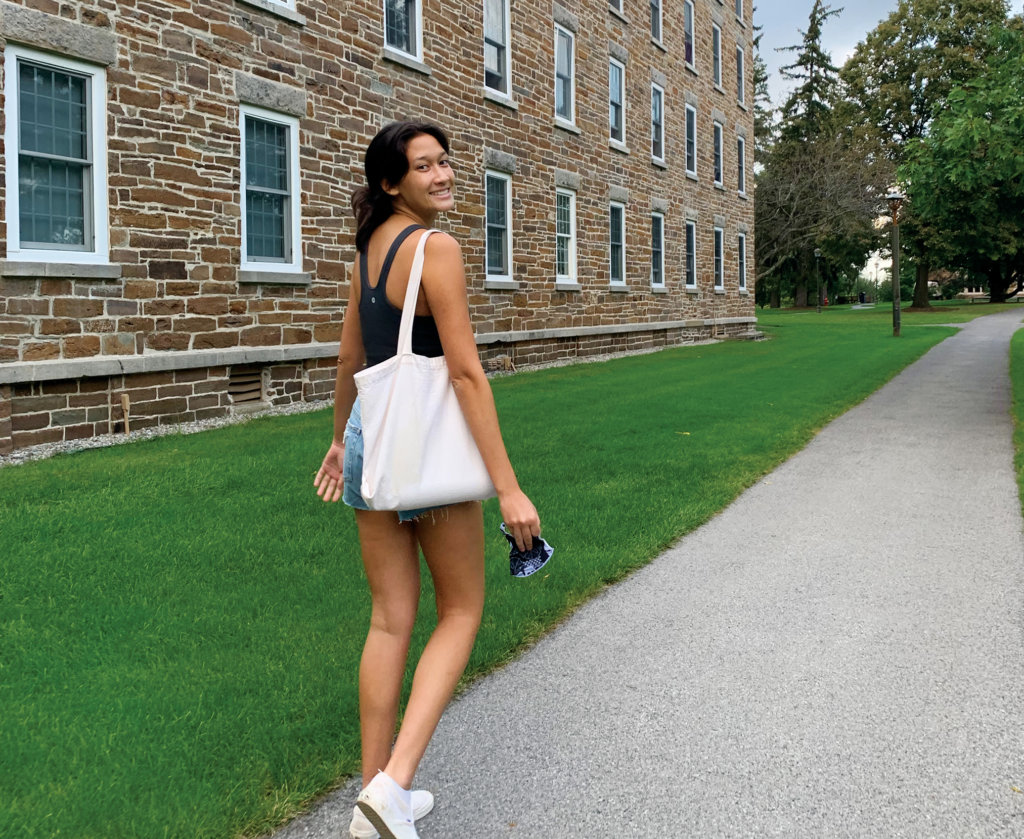
Alumni Perspectives
Anna Sakamoto ’18
HAMILTON COLLEGE
For a teenager approaching life after Punahou with big questions – “I didn’t really know who I was,” Anna Sakamoto ’18 says. “I didn’t really know what I wanted to do,” Sakamoto knew enough to point her with crystal clarity to Hamilton College. Born in Tokyo, she arrived in Hawai‘i at age 7 with her mom, Pamela Rotner Sakamoto, chair of the Academy’s Social Studies Department, and brother, Masa ’15. Geographically, Hawai‘i was midway between her parents’ two cultures; realistically it was far from all her other relatives. So Sakamoto wanted a college in the Northeast, near her mother’s family. (Hamilton is in upstate New York.) She wanted a small school where classes were intimate and she could form meaningful relationships with professors. (Hamilton’s student population is around 2,000.) And she wanted an environment that would let her pursue her curiosities. (Hamilton’s open curriculum favors academic plans tailored to individual student’s interests over a core curriculum.)
“I hope more Punahou students apply to smaller liberal arts schools in the Northeast. Schools like Middlebury College (which my brother, Masa ’15, attended) and Hamilton are just as good as bigger schools, but not as well known.”
– Anna Sakamoto ’18
“I love classes that are like 10 students. I love those discussion-based classes over lectures and presentations,” she says. “Hamilton has really allowed me to experiment in different departments, whether STEM-related fields, Japanese films or sociology. And I like walking across the quad and seeing people I know, just like at Punahou, and being familiar with everyone’s face on campus. Through my sorority and clubs, I’ve gotten to know all different communities on campus. Whereas my friends at other schools, it’s harder to get to know people because they’re at bigger schools.”
Sakamoto’s choice paid off in an unexpected way when Hamilton’s entire 2020 – 2021 academic year took place on campus and in-person, and not with her logging into Zoom sessions from Hawai‘i. If she envies anything about Punahou classmates at big or big-city universities, it’s the lack of diversity among her fellow students. But she’s at Hamilton, after all, so she can do something about this. The environmental studies major has been heavily involved in a research fellowship looking at Asians and Asian Americans in film, and a bigger study looking at these populations on campus; and as of last spring she’s led diversity, equity and inclusion initiatives at her sorority. Which means that for Sakamoto, who chose Hamilton with little doubt, hindsight has also been crystal clear.
– By Mari Taketa

More students seeking financial aid
Rising college costs and the pandemic’s economic toll on families have led more college-bound students to seek financial assistance. This is likewise the case among Punahou students, Academy Principal Emily McCarren said.
The School’s college counselors say more families are bringing up cost concerns as they pinpoint schools, with conversations leading to which schools offer merit-based scholarships and need-based financial aid. If families are looking for merit scholarships, Punahou’s college counselors will discuss colleges where the student will be above the reported GPA and/or testing averages, since these are colleges where the student is likely to be admitted and likely to receive merit-based scholarships.
Punahou’s college counselors also will discuss programs, such as the Western Undergraduate Exchange (WUE), where public colleges in the West offer a tuition exchange for students from Hawai‘i. As part of the exchange, Hawai‘i students will pay in-state tuition plus one half, making it more affordable.
Punahou students also are introduced to other resources that provide information about financial aid and scholarships, including on the MaiaLearning college planning platform.
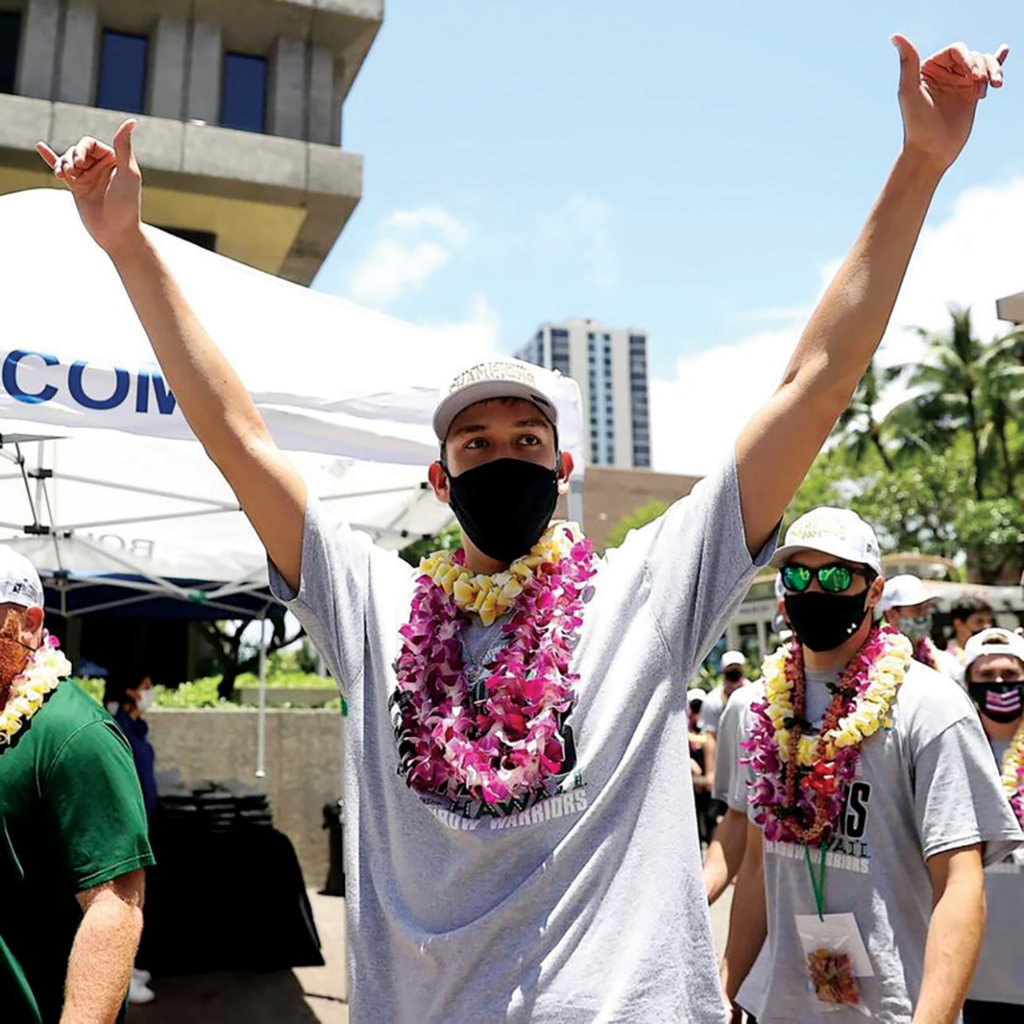
“If you know where you want to go, don’t let other people influence you. You can have a great college experience anywhere you go – it’s all in your attitude and how you experience it. You can make a great situation out of anything. Plus, Punahou prepared us for almost any life situation in college. So if you don’t find what you’re looking for at your first choice, you can always make another decision, find a better fit.”
– Alaka‘i Todd ’18
Alumni Perspectives
Alaka‘i Todd ’18
UNIVERSITY OF HAWAI‘I AT MĀNOA
It wasn’t until his second year at the University of Hawai‘i at Mānoa that Alaka‘i Todd ’18 realized he’d made the right choice. Post-Punahou, everything had been a blur: adjusting to new classes, professors and life on a campus of 18,000 students, not to mention the demands of playing on one of the country’s top collegiate volleyball teams. It was especially so, because as a student in the Academy, Todd thought he had to leave Hawai‘i to find a good college. Then he weighed his priorities – a strong volleyball program, solid business school and student life not centered around partying – and realized the perfect fit was right in his backyard.
“When I was in high school, I got influenced a little bit by other people, and I wasn’t really confident about my decision at first. Halfway through my second year at UH is when I kind of realized, I’m in the right place. I’m always productive. It’s rewarding to know that everybody here is rooting for me and helping me achieve my goals,” he says. “A big quote that stuck with me from my coach during my athletic freshman year was, ‘You don’t want to be a guy. You want to be the guy.’ A lot of the coaches and a lot of the guys really had a great work ethic, and it rubbed off on me.”
Todd’s focus on volleyball – he played opposite hitter and outside hitter positions on Punahou’s powerhouse boys varsity team – would pay off: The UH men’s team is the current NCAA champion. His focus on business hasn’t wavered, either. While a combination of red-shirting his first year and getting back his second because of COVID-19 means he’s now a sophomore on the volleyball team, academically he’s a senior and plans to apply for the two-year MBA program at the Shidler College of Business. “UH is no joke,” he says. “Playing in front of my family and friends – that’s been awesome, and being able to get an amazing education at the Shidler business school, it went hand in hand. No regrets. It’s one of the best decisions I made.”
– By Mari Taketa
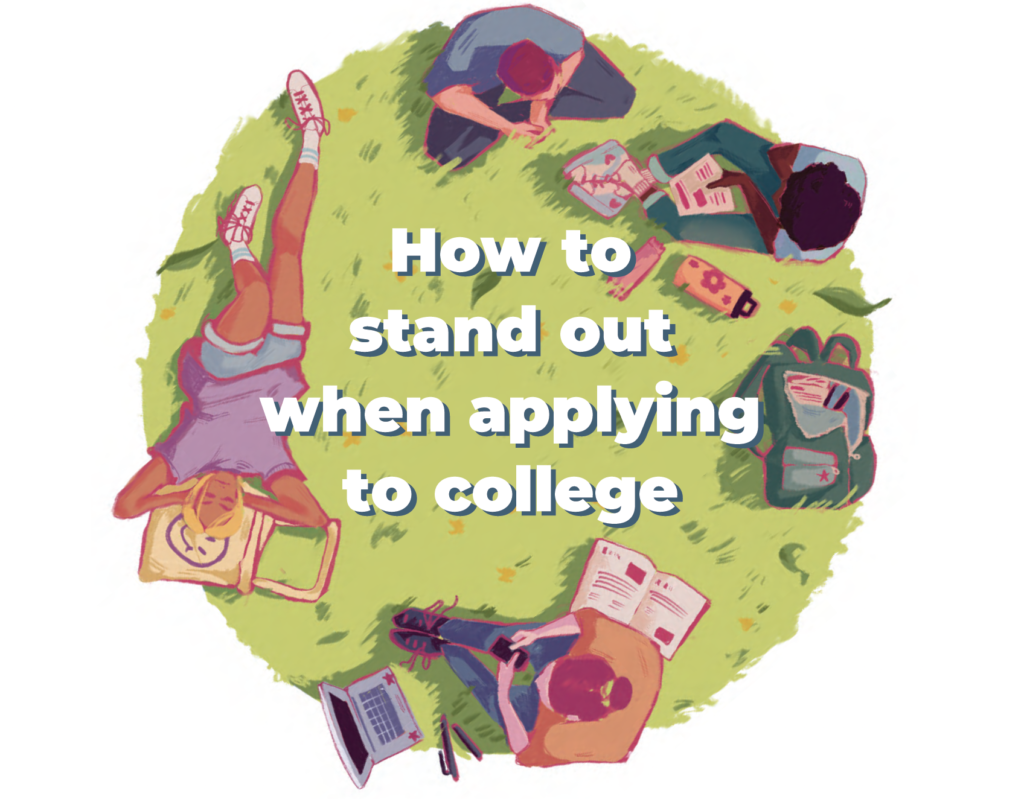
Triple-check applications
The more eyes on application materials, the better chance to catch errors.
Take challenging courses
Taking honors or AP courses can give a significant advantage.
Build solid relationships with teachers and mentors
Recommendation letters can significantly strengthen applications.
Research prospective schools
Browse their websites, review their mission statements and unique characteristics and effectively relay your familiarity and potential fit with a school when applying.
Write a thoughtful and detailed essay displaying your personality
The personal essay is often the most important part of your application so appear authentic while showcasing writing and critical thinking skills.
Audit your social media
College admissions officers often browse applicants’ social media accounts, and their findings affect decisions.
Get your application in early
Acceptance rates are significantly higher for students applying through early action or early decision.
Participate in meaningful extracurricular activities
Aim for quality over quantity, and while most students opt for sports or other school clubs, consider more unique opportunities such as running a small business or self-publishing a book.
Include optional materials
When colleges extend the option to provide additional information, take advantage of it to better reveal yourself and your accomplishments.
College Officials Weigh In
We asked two college officials to offer their perspectives of college admission
Heath Einstein
Dean of Admission, Texas Christian University (TCU)

What are the main things TCU looks for in applicants, and has this changed since the pandemic?
The primary factor in any admission decision is academic preparation. To the extent possible, we want to be sure that students are set up for academic success since our raison d’être is to educate. Beyond that, though, since the majority of applicants can do the work, we seek evidence of community engagement. In particular, since the pandemic started, we are looking for students who have built or are committed to building an inclusive environment.
Has your college been accepting a higher percentage of candidates through early admission?
Traditionally, the majority of incoming TCU students apply via the early action round. Last year it was 55% of our applicant pool.
How does early admission help colleges?
Early decision is a terrific enrollment management tool for three primary reasons. First, there’s yield. Because of the binding nature of early decision, colleges know that for every offer of admission, one student will enroll. Because enrollment managers are expected to deliver on a budgeted headcount, the more we are able to mitigate uncertainty, the easier the process is to manage. Second, there’s the admit rate.
If I only need to admit one student to yield one student, I am able to make fewer offers overall to bring in the desired class. Fewer offers equals a lower admit rate, which equals greater selectivity and greater perceived prestige.
Third, there’s revenue. Students who apply early decision tend to be from more affluent families. Most families aren’t in a position to pay for college without knowing what the scholarship and aid package is going to be. Moreover, many students from low-income families begin the process later and/or do not have access to quality counseling, so they do not even consider early decision. Because most colleges are tuition-dependent, locking in the revenue early is advantageous.
Are you seeing a higher percentage of applicants applying for financial aid?
There is no question that more students are applying for financial aid. Cost of attendance that outpaces inflation coupled with rising income inequality are big drivers. When the pandemic struck, causing economic instability, we implemented austerity measures across our operating budget and poured an additional $65 million into financial aid to meet this increased need.
What advice would you give to current seniors now going through the application process?
Seek an environment that challenges you to be the best version of yourself. Do not get hung up on hallway chatter. Listen to your heart … and your college counselor.
Chad Faber
Director On-Campus & Online Student Engagement and Associate Director of Admission, Northwestern University

What are the main things Northwestern looks for in applicants for admission? Has this changed since the pandemic?
Northwestern continues to review applications in a holistic manner just as we did before the pandemic. Personally, when I’m reading an application the first piece of information I’m going to assess and is of primary importance is the transcript. The transcript was the most important piece of information before the pandemic, during the pandemic and it will remain a focal point after this pandemic is over. It tells the story of your high school courses, the sequence in which you took classes, the rigor of your schedule and rigor of individual classes, in addition to your grades. Northwestern is in an enviable position; we receive nearly 50,000 applications per year for a mere 2,000 beds in the first-year class. We want to build a community of students who can learn from professors, staff and (most importantly) each other.
We are building a community of scholars from all 50 states and nearly 100 foreign countries. If there is a way for me to best summarize what NU is looking for in an applicant, it would be a “distinguishing excellence.” Is there some way in which a particular applicant stands out among other applicants by making an impact in academics, athletics, the arts, their community, research, character, etc. that goes beyond their school or lasts beyond their time in high school? We have lots of standard strong applicants with impeccable grades and activities, but those applications with a distinguishing excellence stand out.
Why are colleges wanting applicants to apply through early decision?
Our president, Morty Shapiro, loves early decision applicants. He loves seeing purple sweatshirts and NU gear being worn around campus by students who “bleed purple.” I’ve heard him say he dislikes seeing other college apparel being worn around campus. We have so many applicants excited about Northwestern and the academic flexibility all students enjoy here, it makes it easy to bring in some great students who have told us in no uncertain terms that Northwestern is their No. 1 choice above all other schools. Wouldn’t you want to be surrounded at a school by people who love where they go and what they study?
Are you seeing a higher percentage of applicants applying for financial aid?
Northwestern continues to be a need-blind, need-based admissions process where we meet 100% of demonstrated need. We do not package loans as part of any financial aid package, and students should graduate debt-free from NU. This year alone, our financial aid budget is $250 million in scholarships and grants that never have to be repaid. We did see an increase in need during the pandemic and given the strength of resources NU has, we were able to respond to individual students. Over 21% of our incoming class comes from a low-income background that makes them eligible for Pell grants from the federal government. This eligibility formula shifts annually, but a typical family of four that makes $50,000 per year or less is eligible for a Pell grant, so NU does have significant socioeconomic diversity.
What advice would you give to high school seniors going through the application process?
» There is no one perfect school out there for any student. There are many, many places where you can thrive and grow. You won’t necessarily be happier at a school just because it has a higher ranking in USNWR than another school you have been admitted to.
» Your senior year grades really matter! Contrary to popular belief, junior year is not the hardest year.
» If you’ve done your research on a school and are writing a supplementary essay about it, but can’t get excited to write it or don’t know what to write about, why are you applying to that school?
» Enjoy your time at Punahou. It will be over before you know, and I can guarantee almost anywhere you choose to go to school will not be as impressive or as beautiful as Punahou.
WHEREABOUTS
Punahou’s Class of 2021 graduates are attending 146 different colleges in 31 states, Washington, D.C., and five other countries.
Class of 2021 – Colleges attending (number of students from Class)

